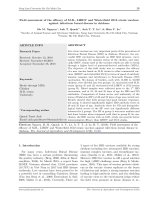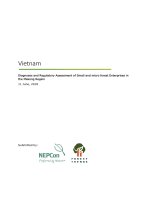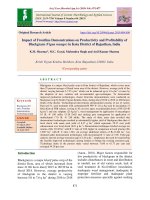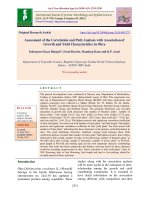Assessment of micro and macro-nutrient status of soil and fodder of Udaipur district of Rajasthan, India
Bạn đang xem bản rút gọn của tài liệu. Xem và tải ngay bản đầy đủ của tài liệu tại đây (306.93 KB, 9 trang )
Int.J.Curr.Microbiol.App.Sci (2019) 8(4): 1042-1050
International Journal of Current Microbiology and Applied Sciences
ISSN: 2319-7706 Volume 8 Number 04 (2019)
Journal homepage:
Original Research Article
/>
Assessment of Micro and Macro-Nutrient Status of Soil and Fodder of
Udaipur District of Rajasthan, India
Lokesh Gupta1, S.C. Meena2*, Amit Kumar3 and Mukesh Panchal3
1
2
Department of Animal Production, RCA, Udaipur, India
Department of Soil Science, Rajasthan College of Agriculture, MPUAT, Udaipur, India
3
Department of Animal Production, India
*Corresponding author
ABSTRACT
Keywords
Soil,
Micronutrients,
Macronutrients,
Nutrient, Fodder,
concentrate
ingredients, Mineral
status, Minerals
deficiency
Article Info
Accepted:
10 March 2019
Available Online:
10 April 2019
An investigation was carried out to estimate the level of selected macro and micronutrients in the soil and fodder of ten tehsils of Udaipur district of Rajasthan. The soil
analysis indicated that moderate amount of major nutrients like Phosphorous, Potassium,
Magnesium and calcium were present in these soils. This study indicated that the soils of
this region were rich in micronutrients viz., Fe and Pb whereas, Mn, Cu and S contents
were intermediate in quantity. On the other hand Zn was found to be deficient in these
soils. The average Ca content in straws (0.45%) was higher, whereas, concentrate
ingredients were particularly low in Ca (0.29 %), except sesame cake. The P content in
crop residues (11 %) and green fodder (35 %) was lower in comparison to concentrate
ingredients (67 %). K content in all fodder was found higher. Fe and Mg level in most of
the fodder was adequate. Fodders were found to be deficient in Zn (except barseem) in
comparison to concentrate ingredients and the average Mn content was deficient in most of
fodders (except grass, wheat straw and Rice straw). The average Cu content was low in
straws (6.61%) whereas, concentrate ingredients were better source of Cu (16.32 ppm). Co
level in most of the fodder was adequate.
Introduction
Among fertilizers, macronutrients including:
nitrogen (N), phosphorus (P) and potassium
(K) play important role in foliar growth, root
development, cell division, flowering, and
seed and fruit formation (Brady, 1984).
Similarly, micronutrients, such as, zinc (Zn),
copper (Cu), iron (Fe), manganese (Mn), etc.
are essential for plant growth, transportation
of nutrients, cell formation, uptake and
retention of other minerals, transformation of
compounds, metabolism and energy cycles.
Deficiency in any single micronutrient may
hamper plant growth and subsequently foliage
yield (Cioroi and Florea, 2003; Mousavi,
2011). The deficiency or unavailability of
these micronutrients are probably the result of
various factors, like calcareous nature and
alkaline reaction soils, introduction of high
yielding varieties and heavy imbalanced
application of macronutrients and low organic
matter. Among the macronutrients, excessive
and indiscriminate use of P-fertilizers can
1042
Int.J.Curr.Microbiol.App.Sci (2019) 8(4): 1042-1050
affect chemical or physiological interactions
in soil-plant systems. These interactions,
known as phosphorus induced micronutrients
disorder (Timmer and Teng, 1990) reduce
solubility of micronutrients (Zn, B, Cu, Fe
and Mn), which leads toward their nonavailability to plants. This phosphorus
induced micronutrients deficiency has been
proved in various soils and crops (Wang et
al., 1990; Ajouri et al., 2004). The health and
degree of productivity of dairy cows and
buffaloes are dependent on balanced and
adequate quantities of all necessary nutrients
to meet their requirement for a given
physiological stage. The usual feed nutrients
given to livestock are proteins for growth and
repair of body tissues, carbohydrates and fats
as sources of energy, minerals and vitamins
for different metabolic functions including
supporting structure of body plus water.
Minerals and vitamins are the most important
nutrients of lactating animals, which are
required in very minute quantity, but have a
great role in metabolism, milk production,
and reproduction and even for microbial
fermentation in the rumen. Livestock in India
do not receive supplements, except for
common salt and calcite/dolomite powder
(Garg et al., 2003b). Hence, dairy animals
depend on forages for their mineral
requirements. A number of researchers have
reported a high incidence of forage samples
below critical levels for different mineral
elements, especially Cu, Zn, P (Miles and
McDowell, 1983; Underwood and suttle,
1999; Garg et al., 2002). On the other hand,
constant efforts are being made to increase
crop yield per hectare through scientific
means for maximizing yields, ensuring more
economic returns to the farmers. However, in
the process of intensive farming practices,
soils from all over the country are getting
depleted for one or more mineral element
resulting in imbalances of mineral elements in
soil, plants and animals. The quantity of
minerals, thus, present in forages may not be
sufficient for optimum growth, milk yield and
reproduction of animals. More than 90
percent of minerals and vitamins deficiency
exists at sub-clinical level in livestock
(Underwood and Suttle, 1999). Even small
imbalances or deficiencies can develop into
reproduction, health and milk production
problems.
Materials and Methods
A survey to assess micro and macro nutrient
status of the soil was conducted in ten tehsils
of Udaipur district. The soil samples collected
from each tehsil were dried and digested in tri
acid and then volume was made to 50 ml. The
nutrients viz., P, Ca, Mg, Fe, Zn, Mn, Cu, Pb
and S were estimated by Atomic Absorption
Spectrophotometer. Phosphorus in soil
samples was estimated colorimetric by AOAC
(1975). At random, one village from each of
the five taluka of Udaipur district was
selected for taking representative samples of
feeds and fodder. Then fodder samples were
dried and ground and digested in tri- acid then
volume was made to 50 ml. Ca, Mg, Cu, Zinc,
Mn and Fe in fodders samples were estimated
by Atomic Absorption Spectrophotometer.
Phosphorus in fodder samples was estimated
colorimetric by AOAC (1975).
Results and Discussion
Mean nutrient status of different micro and
macro nutrients in ten tehsils of Udaipur
district of Rajasthan is presented in the table
1. Under Indian conditions, the mineral
deficiency diseases are quite common and are
mainly due to non-availability of balanced
diet or deficiency of minerals in the soil and
fodder. Phosphorus is the second most
important major nutrient required by plants
after nitrogen for proper growth and
development and like nitrogen, phosphorus
(P) is also an essential part of the process of
photosynthesis, involved in the formation of
1043
Int.J.Curr.Microbiol.App.Sci (2019) 8(4): 1042-1050
all oils, sugars, starches etc. Phosphorous
content was found to be deficient the soils of
Udaipur. The low available phosphorous
content soils might be due to fixation of
available phosphorous by free oxides and
exchangeable aluminium. Potassium is
absorbed by plants in larger amounts than any
other mineral element except nitrogen and, in
some cases, calcium. Potassium contents were
highest in the soils of Kotada, while it as low
in Surada. Higher potassium may be due to
higher organic carbon content as well as due
to addition of potassium bearing fertilizers in
surface horizons. Similar results were
observed by Pal and Singh (1993). The
surface soils of all most all pedons except hill
and valley were generally rich in potassium
content which may be because of
management practices followed in cultivated
soils (Gaikwad et al., 1974). Similar results
have also been observed by Rathore (1993)
and Sharma (1994). The soils of this district
were deficient in Calcium. Magnesium
contents were considerably medium in soils
of Udaipur. These results indicate that P, K
and Ca has to be supplied externally through
organic or in organic fertilizers.
All the investigated micronutrients (Fe, Cu,
Zn and Mn) are influenced by the soil
environment (Brady, 1995). Fe level in all the
soils was adequate. Average Zinc content of
soils of this district was found to be deficient
indicating the need to supply this mineral
externally through Medium manganese
content was found in this district and was
highest in the soils of Mavali and Sallumber.
Cu contents were found to be intermediate in
all tehsils. Soil analysis indicated higher Pb
content in the soils of Udaipur and was
highest in Surada. This study indicated that
the soils of this district were intermediate in S
contents except Rishabhdeo.
These findings are in agreement with the
findings of Bhanderi et al., (2016) for Ca,
Sharma et al., (2015) for Ca, P and Mg, Panda
et al., (2015) for Ca and P, Devi et al., (2014)
for Cu Ramesh et al., (2014) for Cu, and
Sharma et al., (2006) for Ca, P, Mg, Cu and
Zn were found below the critical level.
The variation in the mineral content in
different soil may be due to herbage plant
species, cultivar differences, soil and climatic
conditions in which plants are grown (Turner
et al.1978). Higher concentration Fe, Mg Cu
and Zn soils reported by Choudhary et al.,
(2015), Panda et al., (2015) and Ramesh et
al., (2014) in Soils of Rajasthan, Odisha and
Andhra Pradesh, respectively. Bhat et al.,
(2011) AND Yatoo et al., (2011) had also
reported higher concentration of Ca, P, Mg,
Cu and Zn in Kashmir soils, for Cu in
Kashmir. Similar reports were also reported
earlier by various workers (Shukla et al.,
2010) and Yatoo et al., (2011) had also
reported higher concentration of Ca, P, Mg,
Cu and Zn in Kashmir soils, for Cu in
Kashmir. Similar reports were also reported
earlier by various workers (Shukla et al.,
2010, Gowda et al., 2001. al. (2015), Panda et
al., (2015) and Devi et al., (2014). Yatoo et
al.(2011) reported lower Fe and Zn in
Kashmir, and P in Assam (Kalita et al., 2003),
which was less as compared to present
investigation.
Common feed resources available for feeding
of animals in Udaipur districts located in
tribal belt of Rajasthan were cereal grains,
cereals straws, forest tree leaves and green
grasses. Mineral content of these locally
available feeds and fodder resources fed to
cattle, buffaloes and goats in the tribal belt are
presented in table 2. The average Calcium
content in straws was higher, however P
content was lower in green fodders, straw,
tree leaves and grasses and had wider Ca: P
ratio. Soybean straw showed exceptionally
higher level of calcium (2.08 %). The
concentrate ingredients commonly fed to
1044
Int.J.Curr.Microbiol.App.Sci (2019) 8(4): 1042-1050
animals contained low calcium except sesame
and mustard cake, but high in phosphorus
level. It has been reported that wider Ca: P
ratio interferes in the utilization of these
minerals in animal system. Singh et al (2006)
reported that most of the feedstuffs in the arid
and semiarid regions are poor in P and
responsible for acute to sub acute deficiencies
in animals.
The magnesium levels as estimated in the
samples of crop residues were adequate, the
grains of maize, barley and wheat were found
to contain low levels of mg (0.14 %) and
cottonseed, mustard cake and sesame cake
were good sources of Mg. Earlier studies in
different agro-climatic zones of Rajasthan
also indicated that common feed resources of
semiarid Rajasthan are adequate in Mg
(Shinde et al., 2006). Magnesium is
considered to be an important factor in the
occurrence of grass tetany in animals (Garcia
and Williams, 2000) and necessary for all
phosphate transfer reactions (NRC, 1980). Fe
contents were reasonably higher in all the
feedstuffs of the region. Similar higher Fe
contents of feedstuff across the country have
been reported by several workers (Ramana et
al., 2001, Garg et al., 2005, Shinde et al.,
2007). It has been reported that almost all the
fodders contained higher Fe than required
concentration in semiarid region of rajasthan
(shinde et al., 2006) (Table 3 and Fig. 1–6).
Table.1 Mean nutrient status of different micro and macro nutrients in ten tehsils of Udaipur
district of Rajasthan
S.N
Udaipur
TEHSIL
Critical limits
1
2
3
4
5
6
7
8
9
10
Udaipur
Mavali
Gogunda
Kotada
Kerwada
Jhadol
Lashadi
Surada
Rishabhdeo
Sallumber
P
(kg/ha)
10-25
(kg/ha)
8.50
8.30
7.40
6.90
7.70
11.90
8.90
10.50
8.70
7.80
K(kg/ha)
140-280
(kg/ha)
208.90
208.30
202.20
214.40
208.30
207.00
212.40
201.30
201.90
208.40
Ca
(cmol/kg)
1.5-30
(cmol/kg)
17.50
14.95
15.34
15.64
13.89
13.69
11.81
13.86
16.27
14.54
Mg
(cmol/kg)
1-12
(cmol/kg)
6.74
5.79
5.94
6.82
8.39
7.66
7.14
4.58
9.52
10.44
Fe(ppm)
0.5-1.0
(ppm)
2.45
2.19
2.92
3.01
1.85
2.07
2.10
2.28
2.25
2.29
Zn(ppm) Mn(ppm) Cu(ppm)
2.5-5.8
(ppm)
0.41
0.36
0.51
0.38
0.34
0.41
0.26
0.24
0.42
0.52
2-4
(ppm)
4.15
4.41
2.27
3.18
1.97
4.20
3.86
3.79
3.37
4.41
0.2-0.5
(ppm)
0.33
0.40
0.37
0.18
0.15
0.44
0.44
0.46
0.44
0.35
pb
S
(ppm) (ppm)
1-2
10-15
(ppm (ppm)
2.30
10.60
2.44
10.70
2.44
10.70
2.81
13.00
3.25
11.50
3.43
11.90
3.81
10.00
3.97
10.40
3.95
9.90
3.93
12.20
Table.2 Mean nutrient status of different micro and macro nutrients in fodders of Udaipur
district of Rajasthan
Element
Critical limit
Grass
Wheat straw
Maize straw
Barseem straw
Soyabean straw
Sorghum straw
AVG.
P%
<0.25
0.09
0.06
0.19
0.09
0.35
0.16
0.19
K%
<0.80
1.13
1.69
1.69
1.33
2.52
1.66
1.67
Ca%
<0.30
0.47
0.48
0.41
0.89
2.08
0.37
0.78
Mg%
<0.20
0.23
0.26
0.25
0.40
0.43
0.28
0.31
Mn(ppm)
<40 ppm
43.02
41.42
37.07
34.13
47.06
31.71
39.07
1045
Zn(ppm)
<30 ppm
26.80
11.46
24.82
18.11
36.40
25.36
23.82
Fe(ppm)
< 50 ppm
266.83
312.83
234.67
465.25
554.80
183.20
336.26
Cu(ppm)
<8 ppm
6.48
6.02
6.72
6.87
6.92
6.63
6.61
Co(ppm)
<0.10
0.14
0.21
0.08
0.29
0.25
0.084
0.176
Int.J.Curr.Microbiol.App.Sci (2019) 8(4): 1042-1050
Table.3 Mean nutrient status of different micro and macro nutrients in concentrate feed of
Udaipur district of Rajasthan
SN
1
2
3
4
5
6
7
Fodder
P
(%)
K
(%)
Ca
(%)
Mg
(%)
Mn
(ppm)
Zn
(ppm)
Fe
(ppm)
Cu
(ppm)
Co
(ppm)
Maize seed
Wheat grain
Guar churi
Barley grain
Mustard cake
Sesame cake
Cotton seed
AVG.
0.32
0.37
0.59
0.59
1.21
1.10
0.52
0.67
0.39
0.42
1.42
1.42
1.51
1.21
1.44
1.12
0.021
0.08
0.20
0.22
0.89
2.71
0.33
0.64
0.14
0.15
0.28
0.29
0.45
0.61
0.33
0.33
10.12
36.97
16.42
23.78
72.12
42.12
28.02
32.79
25.21
35.12
58.21
31.12
82.14
114.27
38.01
54.87
90.12
114.25
490.87
130.12
701.12
950.12
440.32
416.70
6.12
9.01
16.45
12.64
17.45
38.12
14.45
16.32
0.33
0.30
0.62
0.60
0.35
0.60
0.35
0.45
Fig. 1
Fig. 2
1046
Int.J.Curr.Microbiol.App.Sci (2019) 8(4): 1042-1050
Fig. 3
Fig. 4
Fig. 5
1047
Int.J.Curr.Microbiol.App.Sci (2019) 8(4): 1042-1050
Fig. 6
The probable explanation could be
contamination of feeds with soil or inert and
insoluble iron dust of machinery origin while
harvesting in field to processing in mills and
other extraction plants. It has been reported
that higher content of Fe in the feed interfered
the copper absorption and metabolism in
animals (Youssef et al., 1999). Zinc was
deficient in all fodders except maize and
sorghum straw. Grains had around 31 ppm
Zn, while mustard and sesame cakes were an
exception with higher Zn content (98 ppm).
Zinc content was found below the critical
level (30 ppm) in most of the crop residues
and needed to be supplemented @80 ppm in
the total ration (Arora, 1981) of animals, to
overcome its deficiency. Zinc deficiency in
fodder of many agro-climatic zones of the
country has been reported (Ramana et al.,
2001, Garg et al., 2003 and udar et al., 2003).
Mn content in fodder was inadequate except
Grass, wheat straw and Soyabean. Amongst
the concentrate ingredients, mustard cake
(72.12 ppm) had the highest Mn content,
followed by sesame cake (42.12 ppm), wheat
grain (36.97 ppm), cottonseed (28.02 ppm)
and barley grain (23.78 ppm). Copper
quantity was recorded low especially in dry
roughages. Straw of rice sorghum, maize,
soybean and wheat contained very low level
of copper and concentrate ingredients were
better source of copper. The cobalt levels in
this zone ranged from 0.081 to 0.29 in straws
and high ranged in concentrate ingredients. A
buffalo, yielding 8 kg milk daily would need
6.0 mg cobalt per day, as per the standard
requirements, whereas, feeds and fodders
available in the area when fed, provide 3.29
mg, showing a deficiency of cobalt (Garg et
al., 2003).
Acknowledgement
Authors are thankful to Rashtriya Krishi
Vikas Yojana, Government of Rajasthan for
providing financial assistance through
research project on Development and
Dissemination of Area Specific Mineral
Mixture for Improving Productivity of
Livestock in Tribal Belt of Rajasthan to
MPUAT, Udaipur.
References
Ajouri, A., Asgedom, H. and Becker, M. Seed
priming enhances germination and
seedling growth of barley under
conditions of P and Zn deficiency.
Journal of Plant Nutrition and Soil
Science,
2004;
167:
630-636.
1048
Int.J.Curr.Microbiol.App.Sci (2019) 8(4): 1042-1050
.
org/10.1002/jpln.200420425
AOAC (1975). Official Methods of Analysis.
Feed total phosphorus estimation by
photometric method. Association of
Official Analytical Chemists, 12 th ed.
Washington, DC.
Bhanderi, B M., Garg M R and Sherasia P L.
2014. Mineral status of feeds, fodder
and dairy animals in Jalgaon district of
Maharashtra state. Scholars J. Agric.
Vet. Sci.1(4A):222-226
Bhat, M S., Shaheen M, Zaman R and Muhee
A. 2011. Mineral inter relationship
among soil, forage and dairy cattle in
Kashmir, India. Vet. World. 4(12):
550-553
Brady, N.C., 1995. The Nature and Properties
of Soils. Prentice Hall of India Private
Ltd., New Delhi.
Choudhary, S., Ramkesh, Choudhry S D and
Yadav P. 2015. Mineral status of
livestock, soil, feeds and fodders in
Ajmer district of Rajasthan. In : 13th
International Grassland Congress
(IGC 2015) held on 24-24 Nov., 2015.
Cioroi, M. and Florea. T. The study of
manganese content in soil, wheat grain
and wheat plants. Ovidius University
Annals of Chemistry, 2003; 14(1): 911.
Devi, G, Sharma M.C., Dimri U, Shekhar P
and Deepa P.M., 2014. Micro-mineral
status of soil, fodders and cattle from
Idukki and Ernakulam districts of
Kerala state, India and their
interrelation. Int. J. Advan. Res. 2(7):
11-15.
Gaikwad ST., Rao YS., Verma HK G (1974).
Characteristics of catenary soils
development on basalt parent rock in
Nagpur district of Maharashtra state. J.
Indian Soc. Soil Sci. 22:181-190.
Gowda, N K S, Prasad C S, Ramana J V and
Shivaramaiah. 2001. Mineral status of
soil, feeds, fodders and animals in
coastal agriculture eco-zone of
Karnataka. Anim. Nutr. Feed Tech. 1:
197-104.
Kalita, D.J., Sarmah B.C,. Sarmah D N and
Mili, D C. 2003. Mineral status and
their relation in lactating cows in
relation to soil, fodder and feed in
Kamrup district of Assam. Indian J.
Anim. Nutr. 20 (4):421-429.
Mousavi, S.R., Zinc in Crop Production and
Interaction
with
Phosphorus.
Australian Journal of Basic and
Applied Sciences, 2011; 5(9): 15031509.
Pal, SK, Singh M (1993). Monitoring the
potassium fertility levels of four soil
seroes from Northern India over a
period of time. J. Indian Soc. Soil Sci.
41:674-677.
Panda, M.K., Panda N, Swain R K, Behera P
C, Sahoo S P, Jena S C and Sahu A R.
2015. Minerals profile of soil, feed,
fodder and serum of dairy cattle in
North Eastern Ghat (Neg) of Odisha.
J.Anim. Res. 5(2):341-346.
Ramesh, S., Nagalakshmi D, Reddy Y R and
Reddy A R. 2014. Mineral status of
soils, water, feeds and fodders of dairy
animals in Mahaboobnagar district of
Andhra Pradesh. Global J. Bio. Sci.
Biotech. 3(3): 273-277.
Rathore, KS., (1993). Characterization and
classification of soils in a catenary
sequence of Jhadole region of
Rajasthan. M. Sc. thesis submitted to
Rajasthan Agriculture of University,
Bikaner.
Sarma, K., Buragohain R and Kalita G. 2015.
Mineral status in soil, fodder and
blood serum of dairy cows in
Mizoram. Indian J. Vet. Anim. Sci.
Res. 44(2) : 142-145.
Sharma, M.C., Kumar P, Joshi C and Kaur H.
2006. Status of serum minerals and
biochemical parameters in cattle of
organized farms and unorganized
1049
Int.J.Curr.Microbiol.App.Sci (2019) 8(4): 1042-1050
farms in western Uttar Pradesh. Asian
J. Anim. Vet. 1(1):33-41.
Sharma, SS., (1994). Characterization and
classification of soils across a
toposequence over basaltic terrain in
humid southern Rajasthan M.Sc. (Ag.)
Thesis, R.A.U., Bikaner, Campus,
Udaipur.
Shukla, S., Tiwari D.P., Mondal B C and
Kumar
A.
2010.
Mineral
interrelationship among soil, plants
and animals in Pithoragarh district of
Uttarakhand. Animal Nutr. Feed Tech.
10: 127-132.
Timmer, V.R., and Teng, Y. Phosphorusinduced micronutrient disorders in
hybrid popular. Responses to zinc and
copper in greenhouse culture. Plant
and Soil, 1990; 126(1): 31-39.
Wang, H.X., Wu, J.L., Zhang, T.J., Wu, O.X.,
Chen, Y., Bian, J.S. and Shaan, F.
Study on interaction between P and Zn
and their influence on the growth of
maize seedlings in calcareous soils.
Acta Pedologica Sinica, 1990; 27(3):
241-249.
Yatoo, M.I., Devi S, Kumar P, Tiwari R and
Sharma M C. 2011. Soil-plant-animal
micro mineral status and their
interrelation in Kashmir valley. Indian
J. Anim. Sci. 81 (6): 68-70.
How to cite this article:
Lokesh Gupta, S.C. Meena, Amit Kumar and Mukesh Panchal. 2019. Assessment of Micro and
Macro-Nutrient Status of Soil and Fodder of Udaipur District of Rajasthan.
Int.J.Curr.Microbiol.App.Sci. 8(04): 1042-1050. doi: />
1050









